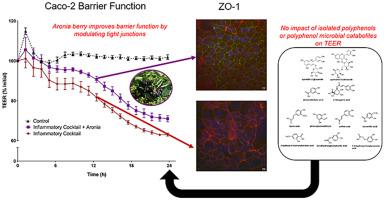Archives of Biochemistry and Biophysics ( IF 3.8 ) Pub Date : 2020-05-25 , DOI: 10.1016/j.abb.2020.108409 Jonathan C Valdez 1 , Junhyo Cho 1 , Bradley W Bolling 1

|
The objective of this work was to determine how aronia berry polyphenols and its microbial catabolites improve intestinal barrier function. Caco-2 cells were cultured on transwell plates and allowed differentiate to form a model intestinal barrier, having baseline transepithelial electrical resistance (TEER) ≥ 300 Ω cm2. Barrier function of differentiated Caco-2 cells was compromised by the addition of an inflammatory cocktail (IC: TNF-α, IL-1β, and IFN-γ to the basolateral media and lipopolysaccharide to the apical media). Polyphenol-rich aronia berry powder or individual polyphenols representative of parent compounds or catabolites were applied to the basolateral media concurrently with IC. TEER was determined subsequently by chopstick electrode or continuous analysis. Permeability was determined by application of 4 kDa FITC-dextran or Lucifer yellow. Expression of tight junction proteins was assessed by qRT-PCR analysis. Application of the IC to differentiated Caco-2 cells routinely reduced TEER by ~40% within 24 h. Individual polyphenols representative of parent compounds or phenolic microbial catabolites at 100 μM did not inhibit IC reduction of TEER in Caco-2 cells. Whole aronia berry powder inhibited loss of TEER by ~50% at 24 h after application of the IC. Furthermore 5 mg/mL of aronia berry powder prevented an IC-induced barrier permeability of FITC-dextran and Lucifer yellow. After 12 h of IC treatment, Caco-2 cells had increased claudin 1 (CLDN1) relative to the untreated control. Application of aronia berry powder inhibited CLDN1 and also increased expression of zonula ocludens-1 (ZO-1) after 12 h. In summary, aronia berry, but not its microbiota-derived catabolites improved intestinal barrier function in a cellular model of chronic colonic inflammation. In this case, improved barrier function was associated with modulation of tight junction expression.
中文翻译:

无花果浆果抑制Caco-2肠屏障功能的破坏。
这项工作的目的是确定阿尼亚浆果多酚及其微生物分解代谢产物如何改善肠屏障功能。将Caco-2细胞培养在Transwell板上,使其分化形成模型肠屏障,其基线经皮上皮电阻(TEER)≥300Ωcm 2。分化的Caco-2细胞的屏障功能被炎性混合物(IC:TNF-α,IL-1β和IFN-γ加入基底外侧培养基,脂多糖加入顶端培养基)所破坏。将富含多酚的无花果浆果粉末或代表母体化合物或分解代谢产物的单个多酚与IC同时应用于基底外侧介质。随后通过筷子电极或连续分析确定TEER。通过应用4kDa FITC-葡聚糖或路西法黄测定渗透率。通过qRT-PCR分析评估紧密连接蛋白的表达。将IC应用于分化的Caco-2细胞后,通常在24小时内可使TEER降低40%。代表母体化合物或酚类微生物分解代谢产物的单个多酚在100μM时不会抑制Caco-2细胞中TEER的IC降低。应用IC后24小时,全草浆果粉抑制TEER的损失约50%。此外,5 mg / mL的无花果浆果粉阻止了FITC-葡聚糖和路西法黄的IC诱导屏障渗透性。经IC治疗12小时后,Caco-2细胞的claudin 1增加(CLDN1)相对于未处理的对照。在12小时后,使用无花果浆果粉可抑制CLDN1,并增加小带闭合带1(ZO-1)的表达。总之,在慢性结肠炎症的细胞模型中,无花果浆果,但其微生物群衍生的分解代谢物不能改善肠屏障功能。在这种情况下,改善的屏障功能与紧密连接表达的调节有关。











































 京公网安备 11010802027423号
京公网安备 11010802027423号